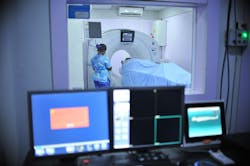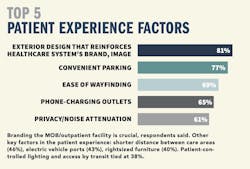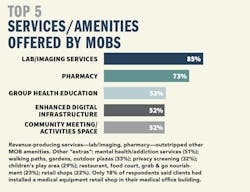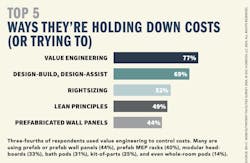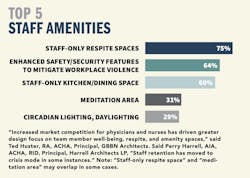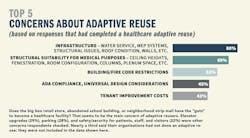Exclusive research: Emerging trends in the $18.3 billion outpatient facilities market
By Robert Cassidy, Executive Editor
Medical office buildings and outpatient facilities are where the action is in healthcare construction. MOB/outpatient buildings accounted for 42% ($18.3 billion) of the $43.4 billion in total healthcare construction in 2022, more than doubling from just 20% in 2012.
The American Society for Health Care Engineering reported a 12% YOY increase in ambulatory facilities for 2024 among healthcare systems it surveyed. JLL, in its recent “Medical Outpatient Building Perspective” report, predicted that “outpatient volumes will continue to grow.” Construction giant Robins & Morton, in its “State of Healthcare Report” (2024), cited data from Syntellis Performance Solutions showing that outpatient revenues at 1,300 hospitals grew by more than 40% compared to 2020.
“Medical development off the hospital campus strives to meet the overarching goals of increasing patient access, closer to the communities it serves, and optimizing patient experience with comprehensive services,” said Laura Schwartz, Vice President of Planning at real estate services firm Meadows & Ohly.
In response to this trend, BD+C surveyed leading healthcare AEC firms and hospital systems regarding their MOB/outpatient work. In early returns, we received 137 valid responses from architects/interior designers (60%), engineers (8%), and construction professionals (18%), nearly half of whom (49%) came from the Top MOB/Outpatient Facilities Firms in BD+C Giants 400 rankings.
Nearly four in five respondents (78%) said their firms had completed imaging facilities in the last two years. Two-thirds (68%) said they had developed, designed, or built MOBs. Other top outpatient building types they delivered: ambulatory surgery centers (72%), cancer-chemo-radiation therapy (63%), and behavioral health/addiction centers (60%).
Client worries: construction costs, interest rates, and labor shortages
Not all is bright and shiny on the outpatient horizon, though. Money issues loom large among the concerns of healthcare systems, according to respondents, two-thirds of whom cited “cost of construction” as their clients’ top concern (chart 1). “By the time the project gets bid out, costs have gone up at least 20%,” said David Glover, AIA, LEED AP, Principal at Champlin Architecture.
The biggest problem AEC healthcare teams face, said Susan Seidel, AIA, LEED AP, a Partner at Holland Basham Architects, is making “construction costs align with possibly unrealistic budgets.” Gina Chang, AIA, EDAC, Principal at CO Architects, said the core problem is “creating value within very limited costs, squeezing spaces to the bare minimum, and dealing with little to no tolerance in construction, while managing changes in technology.”
Healthcare projects also have a unique supply chain problem—a shortage of electrical switchgear/ATS, transformers, generators, and AHUs. “MEP infrastructure is not ‘off the shelf,’” said Joel P. Trexler, ACHA, Principal, JPT Healthcare Consultants. “It must meet stringent ICRA [infection control] and code compliance for medical use.”
Dan Myers, Project Director Vice President at Pepper Construction, said he’s seen “residual malaise from pandemic days” as a way for vendors, subcontractors, and suppliers to simply shrug their shoulders when materials or equipment is late. “‘Supply chain’ has become the stock excuse for individuals failing to do their due diligence In securing materials,” he said.
As one respondent put it, “There’s a misunderstanding by ‘civilians’—board members, physicians, community leaders—that outpatient space can somehow be built for the same cost/time factors as residential or light commercial strip centers.”
Modular, prefab: The path ahead?
Respondents were not throwing in the towel, however. In addition to employing value engineering, design-build/design-assist, and rightsizing to hold down costs (chart 2), many were using prefab wall panels (44%) and MEP racks (40%), modular headboards (33%), bath pods (31%), kit-of-parts systems (25%), and even whole-room pods (14%).
“Modular/prefab continues to be a key driver for cost and schedule efficiency,” said Lendlease’s Rich Steimel, SVP and Principal in Charge–Healthcare. Said Thane M. Eddington, AIA, ACHA, EDAC, Medical Planner at PKA Architects, “Modularity, kit-of-parts structural systems”—PKA uses ConXtech—“and Lean principles are tools designers can use to help address direct construction costs.”
“We are seeing modular and prefabricated building solutions being increasingly favored in outpatient facilities and MOB projects for their efficiency and time-saving benefits,” said Jeanmarie Zimmerman, ACHA, AIA, EDAC, CCIDC, Healthcare and Planning Strategy Leader at AE Works. She cited these benefits: streamlined construction timelines, quicker deployment, quality control, and potential cost savings. “The adaptable nature of these structures allows for future expansions or modifications to meet evolving healthcare needs,” she added.
Innovation leads the way to success
Respondents reported going the extra mile to meet client and patient needs. Gil May, AIA, IIDA, LEED AP, Founding Principal, May Architecture, said that, to enhance patient care at a cancer center, “We created an oncology universal room which supports consultations or exams with multiple physicians, caregivers, infusion, and phlebotomy, all in the same room, so the care comes to the patient instead of the other way around.”
One firm connected an overnight-stay suite with an adjacent ambulatory surgery center. “This allows patients to remain on site after surgery, but not in a recovery room,” said the respondent.
At Clune Construction, “Our use of 360-degree photography enables all stakeholders to track their MOB/outpatient projects from remote locations, such as their office, home, or if they’re in transit,” said Derek Lemmon, VP/Healthcare Team Leader.
“We’re using tilt-wall construction on more of our healthcare facilities,” said Robins & Morton Division Manager Todd Watson. “By self-performing the concrete scope, we can accelerate the structural phase of the project, thanks to our detailed knowledge of the project as general contractor.”
David McLemore, AIA, ACHA, LEED AP, EVP, Director of Healthcare Projects at Kirksey Architecture, said, “We incorporated five-story concrete tilt-wall panel design to assist with speed to market” on a 177,000-sf ASC/cancer center with multispecialty clinics, imaging and diagnostics, lab, and pharmacy services, for Kelsey-Seybold Clinic, Spring, Texas.
At LPA Design Studios, “We’re incorporating wellness programs and services into these facilities—indoor/outdoor pools, multipurpose gymnasiums, running tracks, healing gardens—to promote physical, mental, and emotional well-being,” noted Muhsin Lihony, Director of Healthcare.
A respondent from “a large engineering firm” said the company used Lean principles, integrated project delivery, and CM at risk to focus the team on the project, control project costs, and “allow creativity to be cultivated” by all stakeholders.
Other innovations respondents have implemented recently:
• Drone landing and parking for deliveries
• Standardized clinic rooms, finishes, and OR configurations
• Expedited faculty plan approvals
• Virtual reality renderings of interior finishes and renovated spaces
• All-electric cancer and ambulatory center
• Vegetable gardens, “community-welcoming” features
• Use of data analytics to drive decision making
• Leveraging technology at check-in/check- out to streamline patient flow.
The key to innovation, said Angela Kolosky, ACHA, AIA, NCARB, LEED AP BD+C, Healthcare Planning Market Leader at DesignGroup, is “helping our clients realize cost-effective operational models that can have a real impact on patients and staff while meeting the ROI of the building, then layering on construction innovations like prefab to reduce costs.”
